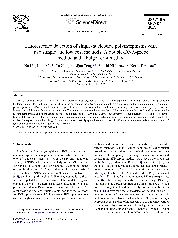摘要
Two 10-mer DNA probes, or one 20-mer DNA probe, respectively, hybridize with a 21-mer target DNA to form a vacancy or bulge opposite the target nucleotide. The former double-DNA-probe method and the latter bulge form method are applicable to the detection of single-nucleotide polymorphisms (SNPs). A small fluorescent dye enters into the vacancy or bulge and binds with a target nucleotide via a hydrogen bonding interaction, which causes fluorescence quenching. The interaction between fluorescent dye and the target nucleotide is confirmed by measuring the melting temperature and fluorescence spectra. The fluorescent dye, ADMND (2-amino-5,7-dimethyl-1,8-naphthyridine), is found to selectively bind with C over A or G. The methods proposed here are economic, convenient, and effective for the fluorescence detection of SNPs. Finally, the double-DNA-probe method and bulge form method are successfully applied to the detection of C/G and C/A mutations in the estrogen receptor 2 gene and progesterone receptor gene using ADMND.
- 出版日期2007-7-30
- 单位清华大学
